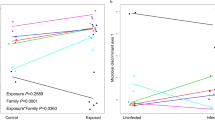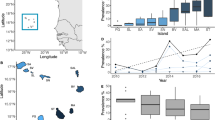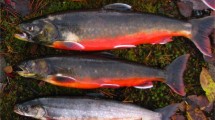Abstract
Reduced parasitic infection rates in the developed world are suspected to underlie the rising prevalence of autoimmune disorders. However, the long-term evolutionary consequences of decreased parasite exposure on an immune system are not well understood. We used the Mexican tetra Astyanax mexicanus to understand how loss of parasite diversity influences the evolutionary trajectory of the vertebrate immune system, by comparing river with cave morphotypes. Here, we present field data affirming a strong reduction in parasite diversity in the cave ecosystem, and show that cavefish immune cells display a more sensitive pro-inflammatory response towards bacterial endotoxins. Surprisingly, other innate cellular immune responses, such as phagocytosis, are drastically decreased in cavefish. Using two independent single-cell approaches, we identified a shift in the overall immune cell composition in cavefish as the underlying cellular mechanism, indicating strong differences in the immune investment strategy. While surface fish invest evenly into the innate and adaptive immune systems, cavefish shifted immune investment to the adaptive immune system, and here, mainly towards specific T-cell populations that promote homeostasis. Additionally, inflammatory responses and immunopathological phenotypes in visceral adipose tissue are drastically reduced in cavefish. Our data indicate that long-term adaptation to low parasite diversity coincides with a more sensitive immune system in cavefish, which is accompanied by a reduction in the immune cells that play a role in mediating the pro-inflammatory response.
This is a preview of subscription content, access via your institution
Access options
Access Nature and 54 other Nature Portfolio journals
Get Nature+, our best-value online-access subscription
$29.99 / 30 days
cancel any time
Subscribe to this journal
Receive 12 digital issues and online access to articles
$119.00 per year
only $9.92 per issue
Buy this article
- Purchase on Springer Link
- Instant access to full article PDF
Prices may be subject to local taxes which are calculated during checkout






Similar content being viewed by others
Data availability
Original data underlying this manuscript can be accessed from the Stowers Original Data Repository at http://www.stowers.org/research/publications/libpb-1391. The scRNA-seq data generated by Cell Ranger can be retrieved from the GEO database with accession number GSE128306.
References
The Global Burden of Disease: 2004 Update (WHO, 2004).
Sheldon, B. C. & Verhulst, S. Ecological immunology: costly parasite defences and trade-offs in evolutionary ecology. Trends Ecol. Evol. 11, 317–321 (1996).
Schmid-Hempel, P. Variation in immune defence as a question of evolutionary ecology. Proc. R. Soc. B. 270, 357–366 (2003).
Schmid-Hempel, P. Evolutionary Parasitology (Oxford Univ. Press, 2013).
Rook, G. A. Regulation of the immune system by biodiversity from the natural environment: an ecosystem service essential to health. Proc. Natl Acad. Sci. USA 110, 18360–18367 (2013).
von Hertzen, L., Hanski, I. & Haahtela, T. Natural immunity. Biodiversity loss and inflammatory diseases are two global megatrends that might be related. EMBO Rep. 12, 1089–1093 (2011).
Belkaid, Y. & Hand, T. W. Role of the microbiota in immunity and inflammation. Cell 157, 121–141 (2014).
Lambrecht, B. N. & Hammad, H. The immunology of the allergy epidemic and the hygiene hypothesis. Nat. Immunol. 18, 1076–1083 (2017).
Rook, G. A., Martinelli, R. & Brunet, L. R. Innate immune responses to mycobacteria and the downregulation of atopic responses. Curr. Opin. Allergy Clin. Immunol. 3, 337–342 (2003).
Rosenblum, M. D., Remedios, K. A. & Abbas, A. K. Mechanisms of human autoimmunity. J. Clin. Invest. 125, 2228–2233 (2015).
Lafferty, K. D. Biodiversity loss decreases parasite diversity: theory and patterns. Philos. Trans. R. Soc. Lond. B 367, 2814–2827 (2012).
Kamiya, T., O’Dwyer, K., Nakagawa, S. & Poulin, R. Host diversity drives parasite diversity: meta-analytical insights into patterns and causal mechanisms. Ecography 37, 689–697 (2014).
McDade, T. W., Georgiev, A. V. & Kuzawa, C. W. Trade-offs between acquired and innate immune defenses in humans. Evol. Med. Public Health 2016, 1–16 (2016).
Lindstrom, K. M., Foufopoulos, J., Parn, H. & Wikelski, M. Immunological investments reflect parasite abundance in island populations of Darwin’s finches. Proc. R. Soc. B 271, 1513–1519 (2004).
Mayer, A., Mora, T., Rivoire, O. & Walczak, A. M. Diversity of immune strategies explained by adaptation to pathogen statistics. Proc. Natl Acad. Sci. USA 113, 8630–8635 (2016).
Scharsack, J. P., Kalbe, M., Harrod, C. & Rauch, G. Habitat-specific adaptation of immune responses of stickleback (Gasterosteus aculeatus) lake and river ecotypes. Proc. R. Soc. B 274, 1523–1532 (2007).
Kaczorowski, K. J. et al. Continuous immunotypes describe human immune variation and predict diverse responses. Proc. Natl Acad. Sci. USA 114, E6097–E6106 (2017).
Herman, A. et al. The role of gene flow in rapid and repeated evolution of cave-related traits in Mexican tetra, Astyanax mexicanus. Mol. Ecol. 27, 4397–4416 (2018).
Fumey, J. et al. Evidence for late Pleistocene origin of Astyanax mexicanus cavefish. BMC Evol. Biol. 18, 43 (2018).
Gibert, J. & Deharveng, L. Subterranean ecosystems: a truncated functional biodiversity. BioScience 52, 473–481 (2002).
Tabin, J. A. et al. Temperature preference of cave and surface populations of Astyanax mexicanus. Dev. Biol. 441, 338–344 (2018).
Abolins, S. et al. The comparative immunology of wild and laboratory mice, Mus musculus domesticus. Nat. Commun. 8, 14811 (2017).
Trama, A. M. et al. Lymphocyte phenotypes in wild-caught rats suggest potential mechanisms underlying increased immune sensitivity in post-industrial environments. Cell Mol. Immunol. 9, 163–174 (2012).
Aspiras, A. C., Rohner, N., Martineau, B., Borowsky, R. L. & Tabin, C. J. Melanocortin 4 receptor mutations contribute to the adaptation of cavefish to nutrient-poor conditions. Proc. Natl Acad. Sci. USA 112, 9668–9673 (2015).
Xiong, S., Krishnan, J., Peuss, R. & Rohner, N. Early adipogenesis contributes to excess fat accumulation in cave populations of Astyanax mexicanus. Dev. Biol. 441, 297–304 (2018).
Wiens, G. D. & Vallejo, R. L. Temporal and pathogen-load dependent changes in rainbow trout (Oncorhynchus mykiss) immune response traits following challenge with biotype 2 Yersinia ruckeri. Fish Shellfish Immunol. 29, 639–647 (2010).
Krishnan, J. et al. Comparative transcriptome analysis of wild and lab populations of Astyanax mexicanus uncovers differential effects of environment and morphotype on gene expression. J. Exp. Zool. B https://doi.org/10.1002/jez.b.22933 (2020).
Moller, A. M., Korytar, T., Kollner, B., Schmidt-Posthaus, H. & Segner, H. The teleostean liver as an immunological organ: intrahepatic immune cells (IHICs) in healthy and benzo[a]pyrene challenged rainbow trout (Oncorhynchus mykiss). Dev. Comp. Immunol. 46, 518–529 (2014).
Traver, D. et al. Transplantation and in vivo imaging of multilineage engraftment in zebrafish bloodless mutants. Nat. Immunol. 4, 1238–1246 (2003).
Stockdale, W. T. et al. Heart regeneration in the Mexican cavefish. Cell Rep. 25, 1997–2007 (2018).
Ramsey, S. et al. Transcriptional noise and cellular heterogeneity in mammalian macrophages. Philos. Trans. R. Soc. Lond. B. 361, 495–506 (2006).
Ogryzko, N. V., Renshaw, S. A. & Wilson, H. L. The IL-1 family in fish: swimming through the muddy waters of inflammasome evolution. Dev. Comp. Immunol. 46, 53–62 (2014).
Wittamer, V., Bertrand, J. Y., Gutschow, P. W. & Traver, D. Characterization of the mononuclear phagocyte system in zebrafish. Blood 117, 7126–7135 (2011).
Sunyer, J. O. Evolutionary and functional relationships of B cells from fish and mammals: Insights into their novel roles in phagocytosis and presentation of particulate antigen. Infect. Disord. Drug Targets 12, 200–212 (2012).
Lugo-Villarino, G. et al. Identification of dendritic antigen-presenting cells in the zebrafish. Proc. Natl Acad. Sci. USA 107, 15850–15855 (2010).
Haugland, G. T. et al. Phagocytosis and respiratory burst activity in lumpsucker (Cyclopterus lumpus L.) leucocytes analysed by flow cytometry. PLoS ONE 7, e47909 (2012).
Lieschke, G. J. & Trede, N. S. Fish immunology. Curr. Biol. 19, R678–R682 (2009).
Balla, K. M. et al. Eosinophils in the zebrafish: prospective isolation, characterization, and eosinophilia induction by helminth determinants. Blood 116, 3944–3954 (2010).
Bolnick, D. I., Shim, K. C., Schmerer, M. & Brock, C. D. Population-specific covariation between immune function and color of nesting male threespine stickleback. PLoS ONE 10, e0126000 (2015).
Peuß, R. et al. Label-independent flow cytometry and unsupervised neural network method for de novo clustering of cell populations. Preprint at bioRxiv https://doi.org/10.1101/603035 (2020).
van der Meer, W., Scott, C. S. & de Keijzer, M. H. Automated flagging influences the inconsistency and bias of band cell and atypical lymphocyte morphological differentials. Clin. Chem. Lab. Med. 42, 371–377 (2004).
Getz, G. S. Thematic review series: the immune system and atherogenesis. Bridging the innate and adaptive immune systems. J. Lipid Res. 46, 619–622 (2005).
Wan, F. et al. Characterization of gammadelta T cells from zebrafish provides insights into their important role in adaptive humoral immunity. Front. Immunol. 7, 675 (2016).
Shilpi, Paul,S. & Lal, G. Role of gamma-delta (gammadelta) T cells in autoimmunity. J. Leukoc. Biol. 97, 259–271 (2015).
Fan, X. & Rudensky, A. Y. Hallmarks of tissue-resident lymphocytes. Cell 164, 1198–1211 (2016).
Papotto, P. H., Reinhardt, A., Prinz, I. & Silva-Santos, B. Innately versatile: gammadelta17 T cells in inflammatory and autoimmune diseases. J. Autoimmun. 87, 26–37 (2018).
Fay, N. S., Larson, E. C. & Jameson, J. M. Chronic Inflammation and gammadelta T. Cells Front. Immunol. 7, 210 (2016).
Rossi, D. J. et al. Cell intrinsic alterations underlie hematopoietic stem cell aging. Proc. Natl Acad. Sci. USA 102, 9194–9199 (2005).
Bolli, N. et al. Expression of the cytoplasmic NPM1 mutant (NPMc+) causes the expansion of hematopoietic cells in zebrafish. Blood 115, 3329–3340 (2010).
Stachura, D. L. et al. Clonal analysis of hematopoietic progenitor cells in the zebrafish. Blood 118, 1274–1282 (2011).
Reavie, L. et al. Regulation of hematopoietic stem cell differentiation by a single ubiquitin ligase-substrate complex. Nat. Immunol. 11, 207–215 (2010).
Cabezas-Wallscheid, N. et al. Identification of regulatory networks in HSCs and their immediate progeny via integrated proteome, transcriptome, and DNA methylome analysis. Cell Stem Cell 15, 507–522 (2014).
Cheng, J. et al. Hematopoietic defects in mice lacking the sialomucin CD34. Blood 87, 479–490 (1996).
Anjos-Afonso, F. et al. CD34(–) cells at the apex of the human hematopoietic stem cell hierarchy have distinctive cellular and molecular signatures. Cell Stem Cell 13, 161–174 (2013).
Amin, R. H. & Schlissel, M. S. Foxo1 directly regulates the transcription of recombination-activating genes during B cell development. Nat. Immunol. 9, 613–622 (2008).
Han, S., Zheng, B., Schatz, D. G., Spanopoulou, E. & Kelsoe, G. Neoteny in lymphocytes: Rag1 and Rag2 expression in germinal center B cells. Science 274, 2094–2097 (1996).
Naito, Y. et al. Germinal center marker GL7 probes activation-dependent repression of N-glycolylneuraminic acid, a sialic acid species involved in the negative modulation of B-cell activation. Mol. Cell Biol. 27, 3008–3022 (2007).
Laszlo, G., Hathcock, K. S., Dickler, H. B. & Hodes, R. J. Characterization of a novel cell-surface molecule expressed on subpopulations of activated T and B cells. J. Immunol. 150, 5252–5262 (1993).
Fänge, R. & Nilsson, S. The fish spleen: structure and function. Experientia 41, 152–158 (1985).
Steinel, N. C. & Bolnick, D. I. Melanomacrophage centers as a histological indicator of immune function in fish and other poikilotherms. Front. Immunol. 8, 827 (2017).
Cervenak, L., Magyar, A., Boja, R. & Laszlo, G. Differential expression of GL7 activation antigen on bone marrow B cell subpopulations and peripheral B cells. Immunol. Lett. 78, 89–96 (2001).
Secombes, C. J., Wang, T. & Bird, S. The interleukins of fish. Dev. Comp. Immunol. 35, 1336–1345 (2011).
Weisberg, S. P. et al. Obesity is associated with macrophage accumulation in adipose tissue. J. Clin. Invest. 112, 1796–1808 (2003).
Christ, A. et al. Western diet triggers NLRP3-dependent innate immune reprogramming. Cell 172, 162–175 e114 (2018).
McAlpine, C. S. et al. Sleep modulates haematopoiesis and protects against atherosclerosis. Nature 566, 383–387 (2019).
Heidt, T. et al. Chronic variable stress activates hematopoietic stem cells. Nat. Med. 20, 754–758 (2014).
Mitchell, R. G., Russell, W. H. & Elliott, W. R. Mexican Eyeless Characin Fishes, Genus Astyanax: Environment, Distribution, and Evolution (Texas Tech Press, 1977).
Espinasa, L. et al. A new cave locality for Astyanax cavefish in Sierra de El Abra, Mexico. Subterr. Biol. 26, 39–53 (2018).
Embryo Surface Sanitation (Egg Bleaching) Protocol https://zebrafish.org/wiki/protocols/ess (ZIRC, 2019).
Peuß, R., Eggert, H., Armitage, S. A. & Kurtz, J. Downregulation of the evolutionary capacitor Hsp90 is mediated by social cues. Proc. R. Soc. B 282, 20152041 (2015).
Pfaffl, M. W., Horgan, G. W. & Dempfle, L. Relative expression software tool (REST(C)) for group-wise comparison and statistical analysis of relative expression results in real-time PCR. Nucleic Acids Res. 30, 36e (2002).
Zhang, Y. A. et al. IgT, a primitive immunoglobulin class specialized in mucosal immunity. Nat. Immunol. 11, 827–835 (2010).
Rowe, R. G., Mandelbaum, J., Zon, L. I. & Daley, G. Q. Engineering hematopoietic stem cells: lessons from development. Cell Stem Cell 18, 707–720 (2016).
Stachura, D. L. et al. The zebrafish granulocyte colony-stimulating factors (Gcsfs): 2 paralogous cytokines and their roles in hematopoietic development and maintenance. Blood 122, 3918–3928 (2013).
de Jong, J. L. & Zon, L. I. Use of the zebrafish system to study primitive and definitive hematopoiesis. Ann. Rev. Genet. 39, 481–501 (2005).
Athanasiadis, E. I. et al. Single-cell RNA-sequencing uncovers transcriptional states and fate decisions in haematopoiesis. Nat. Commun. 8, 2045 (2017).
Zeng, A. et al. Prospectively isolated tetraspanin(+) neoblasts are adult pluripotent stem cells underlying planaria regeneration. Cell 173, 1593–1608 (2018).
Schindelin, J. et al. Fiji: an open-source platform for biological-image analysis. Nat. Methods 9, 676–682 (2012).
Sun, K. et al. Endotrophin triggers adipose tissue fibrosis and metabolic dysfunction. Nat. Commun. 5, 3485 (2014).
R Core Team R: A Language and Environment for Statistical Computing (R Foundation for Statistical Computing, 2014).
Benjamini, Y. & Hochberg, Y. Controlling the false discovery rate: a practical and powerful approach to multiple testing. J. R. Stat. Soc. B 57, 289–300 (1995).
Acknowledgements
We thank the cavefish facility staff at the Stowers Institute for support and husbandry of the fish. We thank the staff from the Histology core at the Stowers Institute for their technical support; J. Blanck from the Cytometry core for performing sorting of HK cells; M. Peterson, A. Peak and A. Perera for support with scRNA-seq; and M. Miller for support with the fish anatomy figure. The authors acknowledge the University of Kansas Medical Center Genomics Core for sequencing support. Furthermore, we thank S. A. McKinney for providing the ImageJ macro for GL-7 quantification. The authors also kindly acknowledge J. Kurtz for helpful discussions. N.R. is supported by institutional funding, funding from the JDRF, the Edward Mallinckrodt Foundation, NIH Grant R01 GM127872 and NSF IOS-1933428 and EDGE award 1923372. R.P. was supported by a grant (no. PE 2807/1-1) from Deutsche Forschungsgemeinschaft.
Author information
Authors and Affiliations
Contributions
R.P. and N.R. conceived the study. R.P. designed and coordinated the experiments with support from A.C.B. and J.K. R.P., J.L.P., A.K. and E.M. collected, dissected and examined cave and surface wild populations with support from J.P.S. R.P. performed and analysed immune assays, flow cytometry experiments and histological analysis, with support from A.C.B., Y.W., D.T. and B.D.S. S.C. performed single-cell sequencing analysis with support from R.P. RNA Scope experiments and analysis were performed by Y.W., D.T. and B.D.S. with support from R.P. and J.K. R.P. and N.R. designed, and R.P. made, the figures. R.P. and N.R. wrote the paper and all authors read and edited the paper.
Corresponding authors
Ethics declarations
Competing interests
The authors declare no competing interests.
Additional information
Peer review information Peer reviewer reports are available.
Publisher’s note Springer Nature remains neutral with regard to jurisdictional claims in published maps and institutional affiliations.
Extended data
Extended Data Fig. 1 A. mexicanus anatomy.
Cartoon of adult A. mexicanus indicates anatomical position of the main hematopoietic and lymphoid organ, the head kidney (HK) that was used for subsequent in vitro experiments from surface fish and cavefish lab strains.
Extended Data Fig. 2. Gene expression of specific head kidney cell types in cavefish and surface fish.
Relative abundance of specific cell populations of surface fish and cavefish and their location within UMAP representation of specific cell types from, a, myelomonocytes and, b, lymphocytes based on the expression of given gene(s). See Supplementary Data 4 for gene enrichment in each cluster.
Supplementary information
Supplementary Information
Supplementary methods, Figs. 1–7, Tables 1–3 and Data 1, 3 and 6–9.
Supplementary Data
Contains Supplementary Data 2, 4, 5 and 10–14. Supplementary Data 2: Statistical summary of phagocytosis experiment shown in Fig. 1g. Supplementary Data 4: List of enriched genes for each cluster for scRNA-seq experiment shown in Fig. 3g. Supplementary Data 5: List of enriched genes for each cluster for scRNA-seq experiment shown in Fig. 4. Supplementary Data 10: Up- and downregulated genes of haematopoietic stem cells in the ‘cavefish PBS’ treatment group compared to the ‘surface PBS’ treatment group from the experimental data shown in Fig. 4. Supplementary Data 11: Up- and downregulated genes of CD4 T cells in the ‘cavefish PBS’ treatment group compared to the ‘surface PBS’ treatment group from the experimental data shown in Fig. 4. Supplementary Data 12: Statistical summary of adaptive immunity response data shown in Fig. 5d,e and Supplementary Fig. 6. Supplementary Data 13: Up- and downregulated genes of neutrophils in the ‘cavefish PBS’ treatment group compared to the ‘surface PBS’ treatment group, and in the ‘cavefish LPS’ treatment group compared to the ‘surface LPS’ treatment group, from the experimental data shown in Fig. 4. Supplementary Data 14: Up- and downregulated genes of macrophages in the ‘cavefish PBS’ treatment group compared to the ‘surface PBS’ treatment group, and in the ‘cavefish LPS’ treatment group compared to the ‘surface LPS’ treatment group, from the experimental data shown in Fig. 4.
Rights and permissions
About this article
Cite this article
Peuß, R., Box, A.C., Chen, S. et al. Adaptation to low parasite abundance affects immune investment and immunopathological responses of cavefish. Nat Ecol Evol 4, 1416–1430 (2020). https://doi.org/10.1038/s41559-020-1234-2
Received:
Accepted:
Published:
Issue Date:
DOI: https://doi.org/10.1038/s41559-020-1234-2
This article is cited by
-
Genetic mapping of craniofacial traits in the Mexican tetra reveals loci associated with bite differences between cave and surface fish
BMC Ecology and Evolution (2023)
-
A new technique to study nutrient flow in host-parasite systems by carbon stable isotope analysis of amino acids and glucose
Scientific Reports (2023)
-
The cavefish Astyanax mexicanus
Nature Methods (2023)
-
A call for more ecologically and evolutionarily relevant studies of immune costs
Evolutionary Ecology (2023)
-
Liver-derived cell lines from cavefish Astyanax mexicanus as an in vitro model for studying metabolic adaptation
Scientific Reports (2022)



